Managing Innovation in Business: Report
VerifiedAdded on 2020/12/30
|10
|3337
|95
AI Summary
Contribute Materials
Your contribution can guide someone’s learning journey. Share your
documents today.
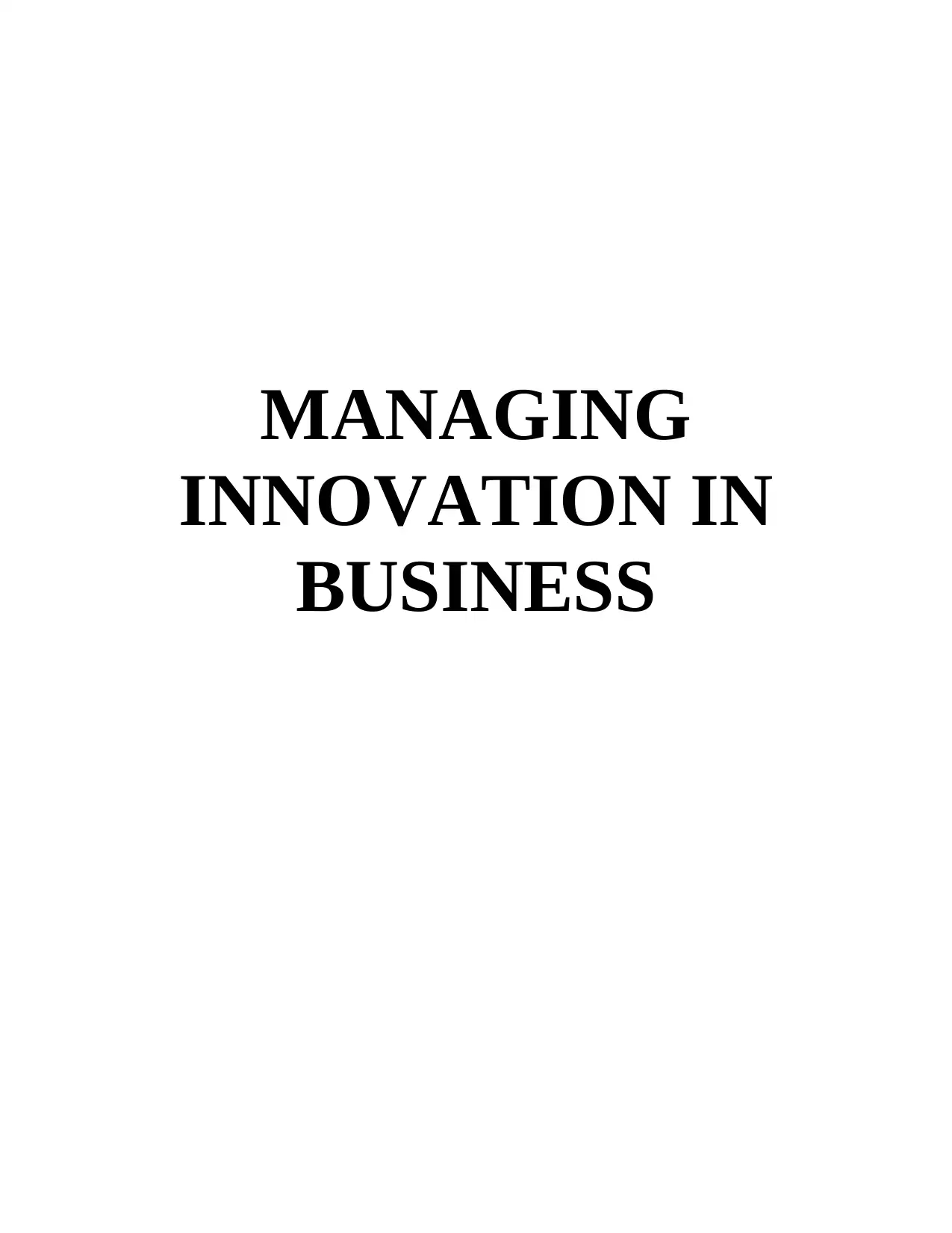
MANAGING
INNOVATION IN
BUSINESS
INNOVATION IN
BUSINESS
Secure Best Marks with AI Grader
Need help grading? Try our AI Grader for instant feedback on your assignments.
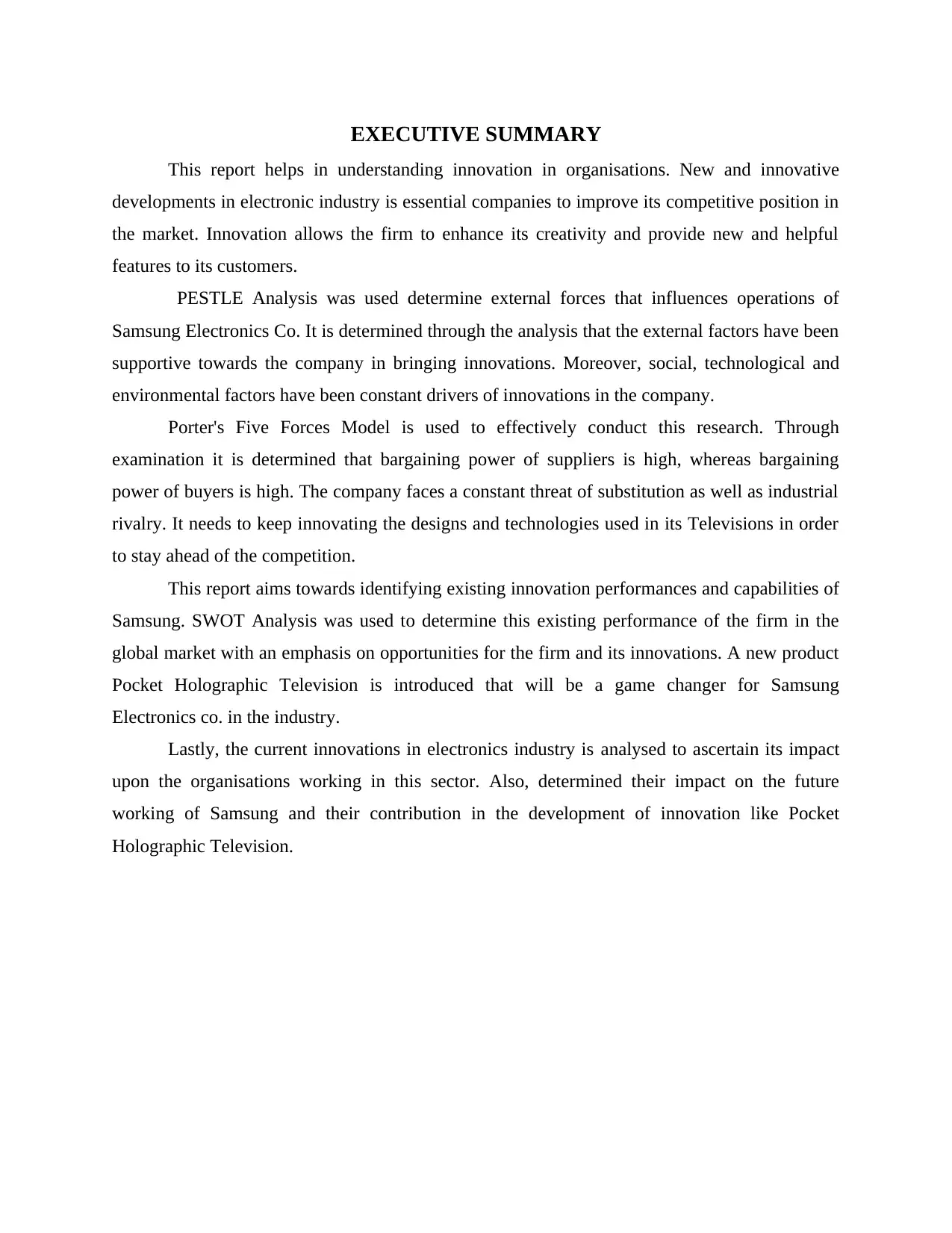
EXECUTIVE SUMMARY
This report helps in understanding innovation in organisations. New and innovative
developments in electronic industry is essential companies to improve its competitive position in
the market. Innovation allows the firm to enhance its creativity and provide new and helpful
features to its customers.
PESTLE Analysis was used determine external forces that influences operations of
Samsung Electronics Co. It is determined through the analysis that the external factors have been
supportive towards the company in bringing innovations. Moreover, social, technological and
environmental factors have been constant drivers of innovations in the company.
Porter's Five Forces Model is used to effectively conduct this research. Through
examination it is determined that bargaining power of suppliers is high, whereas bargaining
power of buyers is high. The company faces a constant threat of substitution as well as industrial
rivalry. It needs to keep innovating the designs and technologies used in its Televisions in order
to stay ahead of the competition.
This report aims towards identifying existing innovation performances and capabilities of
Samsung. SWOT Analysis was used to determine this existing performance of the firm in the
global market with an emphasis on opportunities for the firm and its innovations. A new product
Pocket Holographic Television is introduced that will be a game changer for Samsung
Electronics co. in the industry.
Lastly, the current innovations in electronics industry is analysed to ascertain its impact
upon the organisations working in this sector. Also, determined their impact on the future
working of Samsung and their contribution in the development of innovation like Pocket
Holographic Television.
This report helps in understanding innovation in organisations. New and innovative
developments in electronic industry is essential companies to improve its competitive position in
the market. Innovation allows the firm to enhance its creativity and provide new and helpful
features to its customers.
PESTLE Analysis was used determine external forces that influences operations of
Samsung Electronics Co. It is determined through the analysis that the external factors have been
supportive towards the company in bringing innovations. Moreover, social, technological and
environmental factors have been constant drivers of innovations in the company.
Porter's Five Forces Model is used to effectively conduct this research. Through
examination it is determined that bargaining power of suppliers is high, whereas bargaining
power of buyers is high. The company faces a constant threat of substitution as well as industrial
rivalry. It needs to keep innovating the designs and technologies used in its Televisions in order
to stay ahead of the competition.
This report aims towards identifying existing innovation performances and capabilities of
Samsung. SWOT Analysis was used to determine this existing performance of the firm in the
global market with an emphasis on opportunities for the firm and its innovations. A new product
Pocket Holographic Television is introduced that will be a game changer for Samsung
Electronics co. in the industry.
Lastly, the current innovations in electronics industry is analysed to ascertain its impact
upon the organisations working in this sector. Also, determined their impact on the future
working of Samsung and their contribution in the development of innovation like Pocket
Holographic Television.
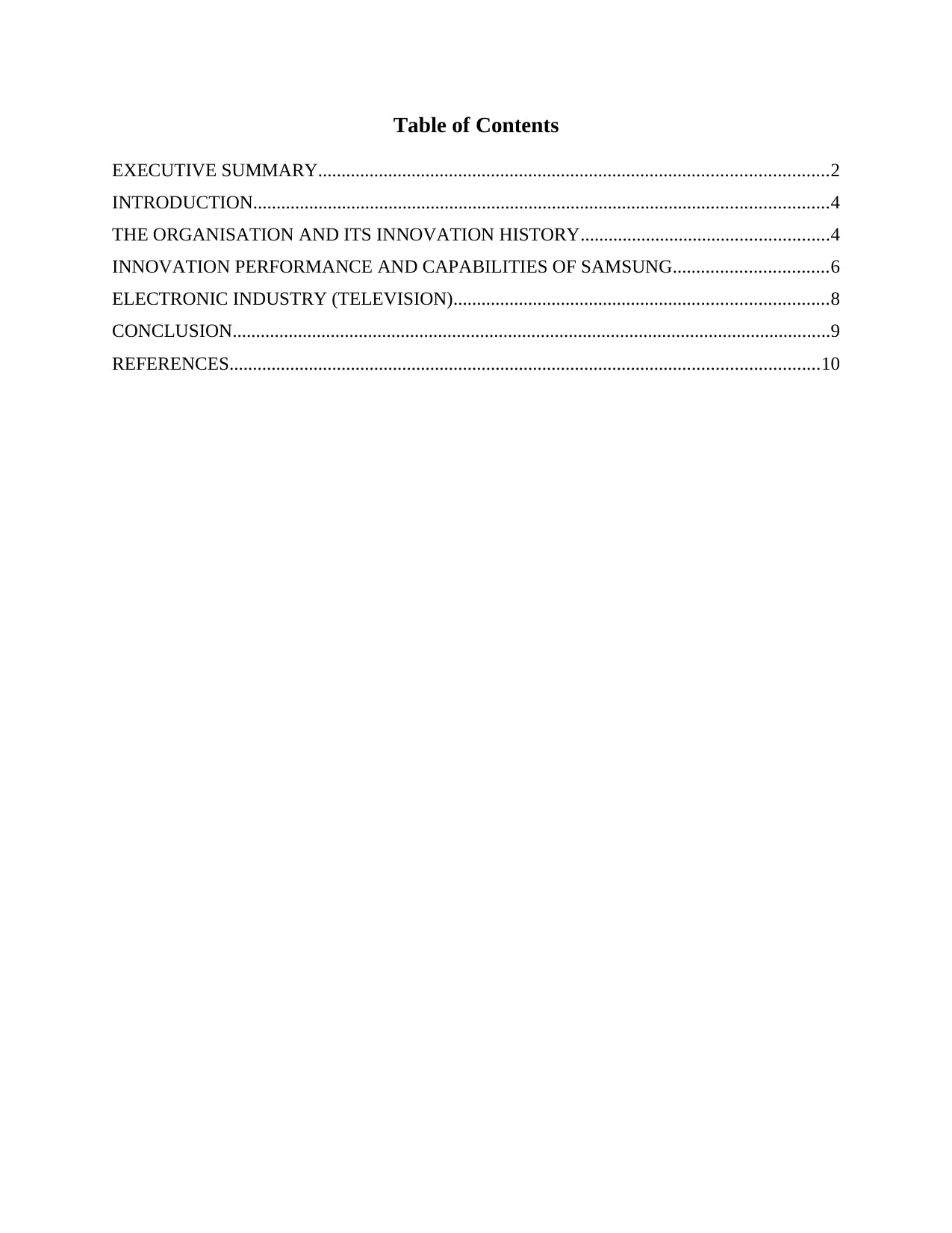
Table of Contents
EXECUTIVE SUMMARY.............................................................................................................2
INTRODUCTION...........................................................................................................................4
THE ORGANISATION AND ITS INNOVATION HISTORY.....................................................4
INNOVATION PERFORMANCE AND CAPABILITIES OF SAMSUNG.................................6
ELECTRONIC INDUSTRY (TELEVISION)................................................................................8
CONCLUSION................................................................................................................................9
REFERENCES..............................................................................................................................10
EXECUTIVE SUMMARY.............................................................................................................2
INTRODUCTION...........................................................................................................................4
THE ORGANISATION AND ITS INNOVATION HISTORY.....................................................4
INNOVATION PERFORMANCE AND CAPABILITIES OF SAMSUNG.................................6
ELECTRONIC INDUSTRY (TELEVISION)................................................................................8
CONCLUSION................................................................................................................................9
REFERENCES..............................................................................................................................10
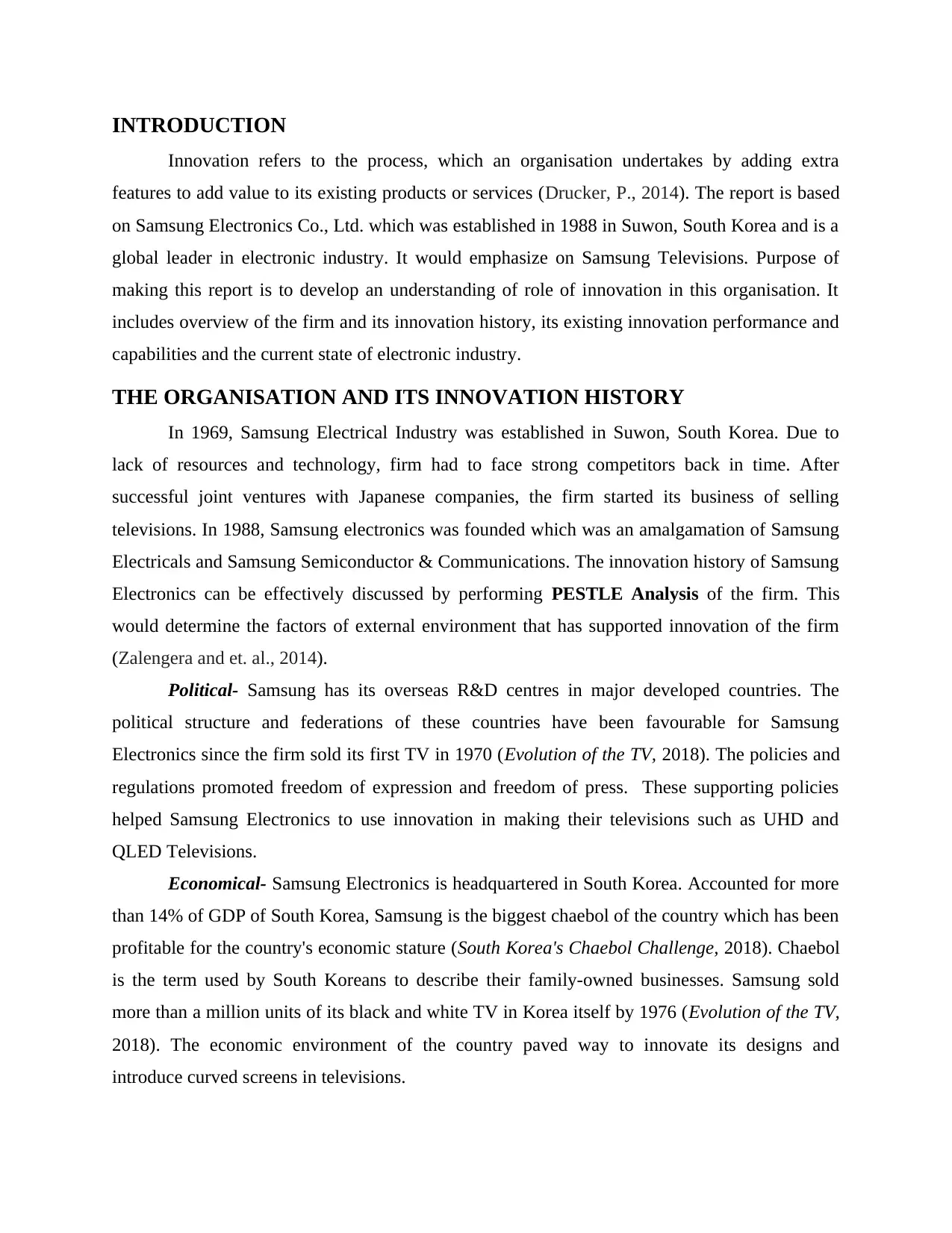
INTRODUCTION
Innovation refers to the process, which an organisation undertakes by adding extra
features to add value to its existing products or services (Drucker, P., 2014). The report is based
on Samsung Electronics Co., Ltd. which was established in 1988 in Suwon, South Korea and is a
global leader in electronic industry. It would emphasize on Samsung Televisions. Purpose of
making this report is to develop an understanding of role of innovation in this organisation. It
includes overview of the firm and its innovation history, its existing innovation performance and
capabilities and the current state of electronic industry.
THE ORGANISATION AND ITS INNOVATION HISTORY
In 1969, Samsung Electrical Industry was established in Suwon, South Korea. Due to
lack of resources and technology, firm had to face strong competitors back in time. After
successful joint ventures with Japanese companies, the firm started its business of selling
televisions. In 1988, Samsung electronics was founded which was an amalgamation of Samsung
Electricals and Samsung Semiconductor & Communications. The innovation history of Samsung
Electronics can be effectively discussed by performing PESTLE Analysis of the firm. This
would determine the factors of external environment that has supported innovation of the firm
(Zalengera and et. al., 2014).
Political- Samsung has its overseas R&D centres in major developed countries. The
political structure and federations of these countries have been favourable for Samsung
Electronics since the firm sold its first TV in 1970 (Evolution of the TV, 2018). The policies and
regulations promoted freedom of expression and freedom of press. These supporting policies
helped Samsung Electronics to use innovation in making their televisions such as UHD and
QLED Televisions.
Economical- Samsung Electronics is headquartered in South Korea. Accounted for more
than 14% of GDP of South Korea, Samsung is the biggest chaebol of the country which has been
profitable for the country's economic stature (South Korea's Chaebol Challenge, 2018). Chaebol
is the term used by South Koreans to describe their family-owned businesses. Samsung sold
more than a million units of its black and white TV in Korea itself by 1976 (Evolution of the TV,
2018). The economic environment of the country paved way to innovate its designs and
introduce curved screens in televisions.
Innovation refers to the process, which an organisation undertakes by adding extra
features to add value to its existing products or services (Drucker, P., 2014). The report is based
on Samsung Electronics Co., Ltd. which was established in 1988 in Suwon, South Korea and is a
global leader in electronic industry. It would emphasize on Samsung Televisions. Purpose of
making this report is to develop an understanding of role of innovation in this organisation. It
includes overview of the firm and its innovation history, its existing innovation performance and
capabilities and the current state of electronic industry.
THE ORGANISATION AND ITS INNOVATION HISTORY
In 1969, Samsung Electrical Industry was established in Suwon, South Korea. Due to
lack of resources and technology, firm had to face strong competitors back in time. After
successful joint ventures with Japanese companies, the firm started its business of selling
televisions. In 1988, Samsung electronics was founded which was an amalgamation of Samsung
Electricals and Samsung Semiconductor & Communications. The innovation history of Samsung
Electronics can be effectively discussed by performing PESTLE Analysis of the firm. This
would determine the factors of external environment that has supported innovation of the firm
(Zalengera and et. al., 2014).
Political- Samsung has its overseas R&D centres in major developed countries. The
political structure and federations of these countries have been favourable for Samsung
Electronics since the firm sold its first TV in 1970 (Evolution of the TV, 2018). The policies and
regulations promoted freedom of expression and freedom of press. These supporting policies
helped Samsung Electronics to use innovation in making their televisions such as UHD and
QLED Televisions.
Economical- Samsung Electronics is headquartered in South Korea. Accounted for more
than 14% of GDP of South Korea, Samsung is the biggest chaebol of the country which has been
profitable for the country's economic stature (South Korea's Chaebol Challenge, 2018). Chaebol
is the term used by South Koreans to describe their family-owned businesses. Samsung sold
more than a million units of its black and white TV in Korea itself by 1976 (Evolution of the TV,
2018). The economic environment of the country paved way to innovate its designs and
introduce curved screens in televisions.
Secure Best Marks with AI Grader
Need help grading? Try our AI Grader for instant feedback on your assignments.

Social- In many developed countries, with rise in films, fashion trends and sports, the
culture of countries' youth shifted towards televisions. 1998 marked the year of world's first
digital TV that was developed by Samsung Electronics. It was widely accepted by the population
of these countries. Their increasing demand of improvisation in their experience of entertainment
has been a constant driver of innovation in Samsung Televisions.
Technological- Samsung in 2006, launched Bordeaux, which had LCD display and wine
glass-inspired form. By this time, almost all the major developed and developing countries were
inclining towards use of superior technology which became another driver of innovation in
Samsung to redefine its television designs. ([Infographic] Looking Back at Samsung’s Milestone
TV Innovations, 2018). Around this time, the company presented Crystal Rose LCD TV in the
market which marked the use of double injection technology for the first time.
Legal- Legal environments of countries like South Korea, US and UK made it accessible
for Samsung electronics to patent designs of its televisions to secure the innovations from
infringements. Such exceptional legal structure helped the company develop world's first
slimmest TV in 2009 ([Infographic] A Timeline of Samsung Electronics’ Firsts in the TV
Industry, 2018)
Environmental- Environment has become a major concern for the world. Televisions
contained hazardous innards. They emitted chemicals like brominated flame retardants and
hormone disrupters polovinyl chloride. These factors became the drivers of innovation for the
firm and Samsung Electronics took initiative and developed OLED televisions that were less
hazardous than other LCD televisions present in the market.
To determine its industrial attractiveness on basis of its innovation, Porter's Five Forces
Model could be an appropriate approach for Samsung Electronics (E. Dobbs, 2014).
Supplier Power- Earlier, with limited suppliers, their bargaining power was higher than
the firm. However, with introducing some of the world's first television designs like Dual-Colour
Bezel; it increased its suppliers all over the world like Digi-Key Electronics and Avnet Abacus in
United Kingdom, thus, decreasing their bargaining power.
Buyer Power- Bargaining power of buyers was higher earlier with existing competition
in the market. Yet in the present scenario, buyers' power is high due to aggressive pricing of the
company. Reason for this pricing is the innovative designs like curved screens introduced by the
culture of countries' youth shifted towards televisions. 1998 marked the year of world's first
digital TV that was developed by Samsung Electronics. It was widely accepted by the population
of these countries. Their increasing demand of improvisation in their experience of entertainment
has been a constant driver of innovation in Samsung Televisions.
Technological- Samsung in 2006, launched Bordeaux, which had LCD display and wine
glass-inspired form. By this time, almost all the major developed and developing countries were
inclining towards use of superior technology which became another driver of innovation in
Samsung to redefine its television designs. ([Infographic] Looking Back at Samsung’s Milestone
TV Innovations, 2018). Around this time, the company presented Crystal Rose LCD TV in the
market which marked the use of double injection technology for the first time.
Legal- Legal environments of countries like South Korea, US and UK made it accessible
for Samsung electronics to patent designs of its televisions to secure the innovations from
infringements. Such exceptional legal structure helped the company develop world's first
slimmest TV in 2009 ([Infographic] A Timeline of Samsung Electronics’ Firsts in the TV
Industry, 2018)
Environmental- Environment has become a major concern for the world. Televisions
contained hazardous innards. They emitted chemicals like brominated flame retardants and
hormone disrupters polovinyl chloride. These factors became the drivers of innovation for the
firm and Samsung Electronics took initiative and developed OLED televisions that were less
hazardous than other LCD televisions present in the market.
To determine its industrial attractiveness on basis of its innovation, Porter's Five Forces
Model could be an appropriate approach for Samsung Electronics (E. Dobbs, 2014).
Supplier Power- Earlier, with limited suppliers, their bargaining power was higher than
the firm. However, with introducing some of the world's first television designs like Dual-Colour
Bezel; it increased its suppliers all over the world like Digi-Key Electronics and Avnet Abacus in
United Kingdom, thus, decreasing their bargaining power.
Buyer Power- Bargaining power of buyers was higher earlier with existing competition
in the market. Yet in the present scenario, buyers' power is high due to aggressive pricing of the
company. Reason for this pricing is the innovative designs like curved screens introduced by the
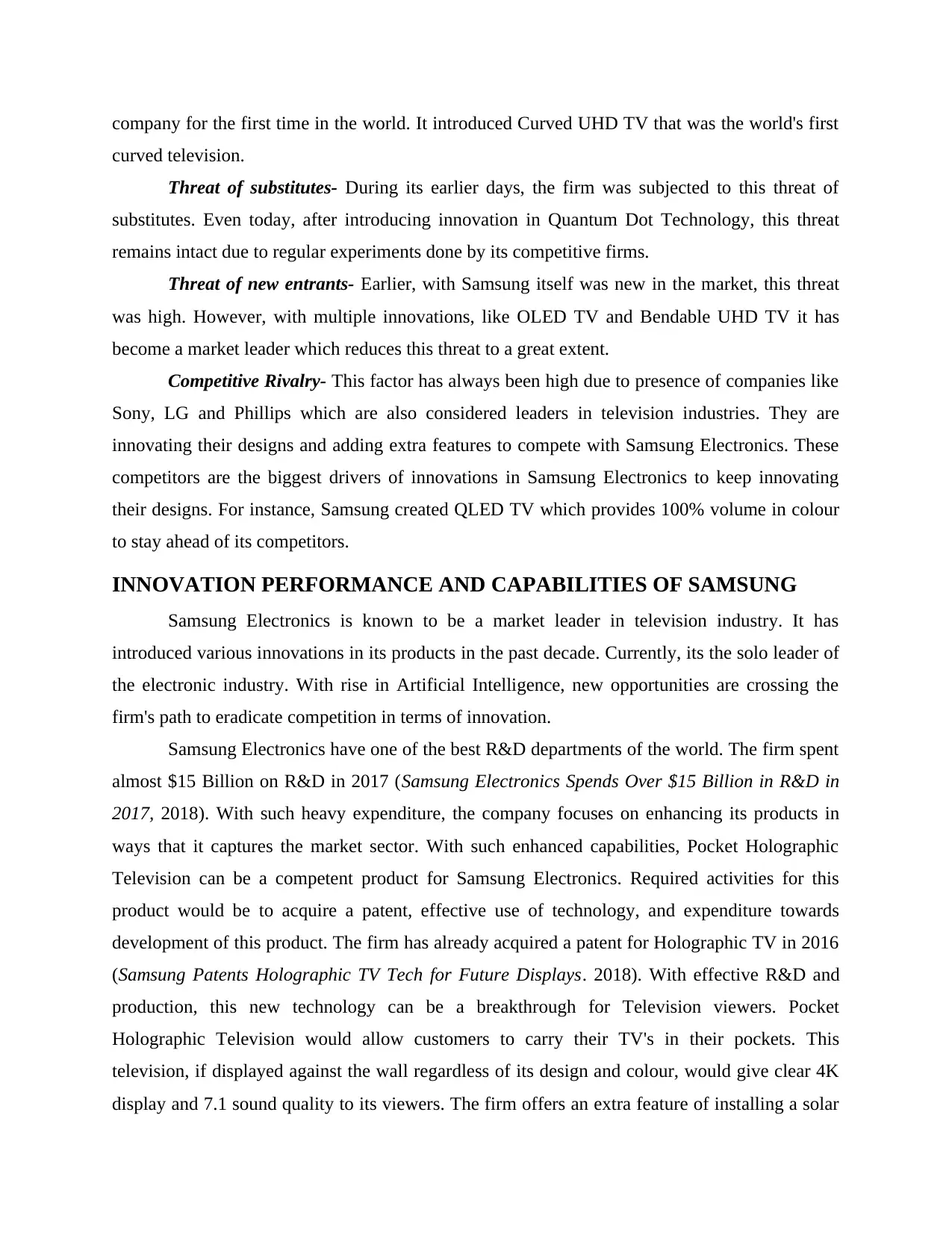
company for the first time in the world. It introduced Curved UHD TV that was the world's first
curved television.
Threat of substitutes- During its earlier days, the firm was subjected to this threat of
substitutes. Even today, after introducing innovation in Quantum Dot Technology, this threat
remains intact due to regular experiments done by its competitive firms.
Threat of new entrants- Earlier, with Samsung itself was new in the market, this threat
was high. However, with multiple innovations, like OLED TV and Bendable UHD TV it has
become a market leader which reduces this threat to a great extent.
Competitive Rivalry- This factor has always been high due to presence of companies like
Sony, LG and Phillips which are also considered leaders in television industries. They are
innovating their designs and adding extra features to compete with Samsung Electronics. These
competitors are the biggest drivers of innovations in Samsung Electronics to keep innovating
their designs. For instance, Samsung created QLED TV which provides 100% volume in colour
to stay ahead of its competitors.
INNOVATION PERFORMANCE AND CAPABILITIES OF SAMSUNG
Samsung Electronics is known to be a market leader in television industry. It has
introduced various innovations in its products in the past decade. Currently, its the solo leader of
the electronic industry. With rise in Artificial Intelligence, new opportunities are crossing the
firm's path to eradicate competition in terms of innovation.
Samsung Electronics have one of the best R&D departments of the world. The firm spent
almost $15 Billion on R&D in 2017 (Samsung Electronics Spends Over $15 Billion in R&D in
2017, 2018). With such heavy expenditure, the company focuses on enhancing its products in
ways that it captures the market sector. With such enhanced capabilities, Pocket Holographic
Television can be a competent product for Samsung Electronics. Required activities for this
product would be to acquire a patent, effective use of technology, and expenditure towards
development of this product. The firm has already acquired a patent for Holographic TV in 2016
(Samsung Patents Holographic TV Tech for Future Displays. 2018). With effective R&D and
production, this new technology can be a breakthrough for Television viewers. Pocket
Holographic Television would allow customers to carry their TV's in their pockets. This
television, if displayed against the wall regardless of its design and colour, would give clear 4K
display and 7.1 sound quality to its viewers. The firm offers an extra feature of installing a solar
curved television.
Threat of substitutes- During its earlier days, the firm was subjected to this threat of
substitutes. Even today, after introducing innovation in Quantum Dot Technology, this threat
remains intact due to regular experiments done by its competitive firms.
Threat of new entrants- Earlier, with Samsung itself was new in the market, this threat
was high. However, with multiple innovations, like OLED TV and Bendable UHD TV it has
become a market leader which reduces this threat to a great extent.
Competitive Rivalry- This factor has always been high due to presence of companies like
Sony, LG and Phillips which are also considered leaders in television industries. They are
innovating their designs and adding extra features to compete with Samsung Electronics. These
competitors are the biggest drivers of innovations in Samsung Electronics to keep innovating
their designs. For instance, Samsung created QLED TV which provides 100% volume in colour
to stay ahead of its competitors.
INNOVATION PERFORMANCE AND CAPABILITIES OF SAMSUNG
Samsung Electronics is known to be a market leader in television industry. It has
introduced various innovations in its products in the past decade. Currently, its the solo leader of
the electronic industry. With rise in Artificial Intelligence, new opportunities are crossing the
firm's path to eradicate competition in terms of innovation.
Samsung Electronics have one of the best R&D departments of the world. The firm spent
almost $15 Billion on R&D in 2017 (Samsung Electronics Spends Over $15 Billion in R&D in
2017, 2018). With such heavy expenditure, the company focuses on enhancing its products in
ways that it captures the market sector. With such enhanced capabilities, Pocket Holographic
Television can be a competent product for Samsung Electronics. Required activities for this
product would be to acquire a patent, effective use of technology, and expenditure towards
development of this product. The firm has already acquired a patent for Holographic TV in 2016
(Samsung Patents Holographic TV Tech for Future Displays. 2018). With effective R&D and
production, this new technology can be a breakthrough for Television viewers. Pocket
Holographic Television would allow customers to carry their TV's in their pockets. This
television, if displayed against the wall regardless of its design and colour, would give clear 4K
display and 7.1 sound quality to its viewers. The firm offers an extra feature of installing a solar
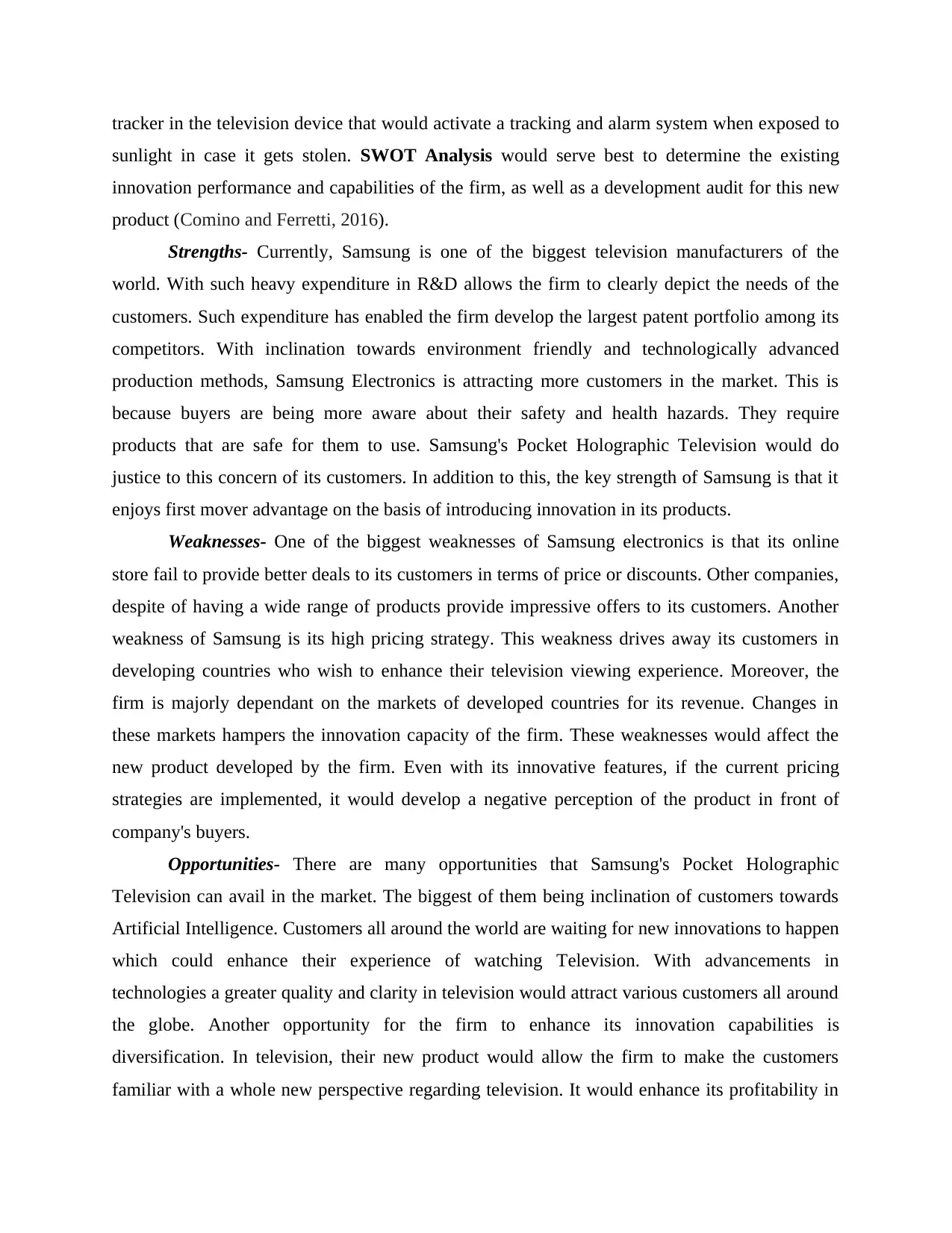
tracker in the television device that would activate a tracking and alarm system when exposed to
sunlight in case it gets stolen. SWOT Analysis would serve best to determine the existing
innovation performance and capabilities of the firm, as well as a development audit for this new
product (Comino and Ferretti, 2016).
Strengths- Currently, Samsung is one of the biggest television manufacturers of the
world. With such heavy expenditure in R&D allows the firm to clearly depict the needs of the
customers. Such expenditure has enabled the firm develop the largest patent portfolio among its
competitors. With inclination towards environment friendly and technologically advanced
production methods, Samsung Electronics is attracting more customers in the market. This is
because buyers are being more aware about their safety and health hazards. They require
products that are safe for them to use. Samsung's Pocket Holographic Television would do
justice to this concern of its customers. In addition to this, the key strength of Samsung is that it
enjoys first mover advantage on the basis of introducing innovation in its products.
Weaknesses- One of the biggest weaknesses of Samsung electronics is that its online
store fail to provide better deals to its customers in terms of price or discounts. Other companies,
despite of having a wide range of products provide impressive offers to its customers. Another
weakness of Samsung is its high pricing strategy. This weakness drives away its customers in
developing countries who wish to enhance their television viewing experience. Moreover, the
firm is majorly dependant on the markets of developed countries for its revenue. Changes in
these markets hampers the innovation capacity of the firm. These weaknesses would affect the
new product developed by the firm. Even with its innovative features, if the current pricing
strategies are implemented, it would develop a negative perception of the product in front of
company's buyers.
Opportunities- There are many opportunities that Samsung's Pocket Holographic
Television can avail in the market. The biggest of them being inclination of customers towards
Artificial Intelligence. Customers all around the world are waiting for new innovations to happen
which could enhance their experience of watching Television. With advancements in
technologies a greater quality and clarity in television would attract various customers all around
the globe. Another opportunity for the firm to enhance its innovation capabilities is
diversification. In television, their new product would allow the firm to make the customers
familiar with a whole new perspective regarding television. It would enhance its profitability in
sunlight in case it gets stolen. SWOT Analysis would serve best to determine the existing
innovation performance and capabilities of the firm, as well as a development audit for this new
product (Comino and Ferretti, 2016).
Strengths- Currently, Samsung is one of the biggest television manufacturers of the
world. With such heavy expenditure in R&D allows the firm to clearly depict the needs of the
customers. Such expenditure has enabled the firm develop the largest patent portfolio among its
competitors. With inclination towards environment friendly and technologically advanced
production methods, Samsung Electronics is attracting more customers in the market. This is
because buyers are being more aware about their safety and health hazards. They require
products that are safe for them to use. Samsung's Pocket Holographic Television would do
justice to this concern of its customers. In addition to this, the key strength of Samsung is that it
enjoys first mover advantage on the basis of introducing innovation in its products.
Weaknesses- One of the biggest weaknesses of Samsung electronics is that its online
store fail to provide better deals to its customers in terms of price or discounts. Other companies,
despite of having a wide range of products provide impressive offers to its customers. Another
weakness of Samsung is its high pricing strategy. This weakness drives away its customers in
developing countries who wish to enhance their television viewing experience. Moreover, the
firm is majorly dependant on the markets of developed countries for its revenue. Changes in
these markets hampers the innovation capacity of the firm. These weaknesses would affect the
new product developed by the firm. Even with its innovative features, if the current pricing
strategies are implemented, it would develop a negative perception of the product in front of
company's buyers.
Opportunities- There are many opportunities that Samsung's Pocket Holographic
Television can avail in the market. The biggest of them being inclination of customers towards
Artificial Intelligence. Customers all around the world are waiting for new innovations to happen
which could enhance their experience of watching Television. With advancements in
technologies a greater quality and clarity in television would attract various customers all around
the globe. Another opportunity for the firm to enhance its innovation capabilities is
diversification. In television, their new product would allow the firm to make the customers
familiar with a whole new perspective regarding television. It would enhance its profitability in
Paraphrase This Document
Need a fresh take? Get an instant paraphrase of this document with our AI Paraphraser
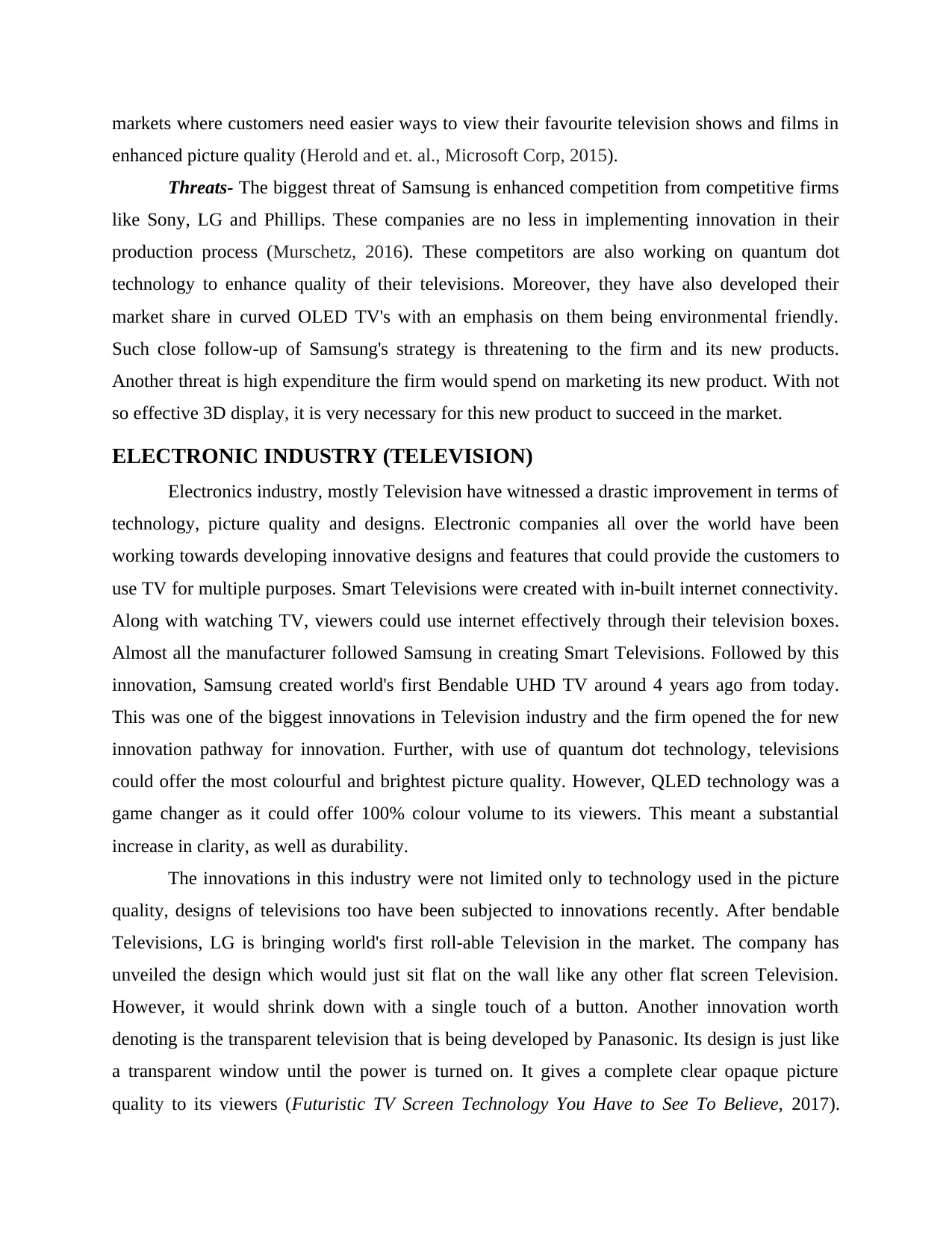
markets where customers need easier ways to view their favourite television shows and films in
enhanced picture quality (Herold and et. al., Microsoft Corp, 2015).
Threats- The biggest threat of Samsung is enhanced competition from competitive firms
like Sony, LG and Phillips. These companies are no less in implementing innovation in their
production process (Murschetz, 2016). These competitors are also working on quantum dot
technology to enhance quality of their televisions. Moreover, they have also developed their
market share in curved OLED TV's with an emphasis on them being environmental friendly.
Such close follow-up of Samsung's strategy is threatening to the firm and its new products.
Another threat is high expenditure the firm would spend on marketing its new product. With not
so effective 3D display, it is very necessary for this new product to succeed in the market.
ELECTRONIC INDUSTRY (TELEVISION)
Electronics industry, mostly Television have witnessed a drastic improvement in terms of
technology, picture quality and designs. Electronic companies all over the world have been
working towards developing innovative designs and features that could provide the customers to
use TV for multiple purposes. Smart Televisions were created with in-built internet connectivity.
Along with watching TV, viewers could use internet effectively through their television boxes.
Almost all the manufacturer followed Samsung in creating Smart Televisions. Followed by this
innovation, Samsung created world's first Bendable UHD TV around 4 years ago from today.
This was one of the biggest innovations in Television industry and the firm opened the for new
innovation pathway for innovation. Further, with use of quantum dot technology, televisions
could offer the most colourful and brightest picture quality. However, QLED technology was a
game changer as it could offer 100% colour volume to its viewers. This meant a substantial
increase in clarity, as well as durability.
The innovations in this industry were not limited only to technology used in the picture
quality, designs of televisions too have been subjected to innovations recently. After bendable
Televisions, LG is bringing world's first roll-able Television in the market. The company has
unveiled the design which would just sit flat on the wall like any other flat screen Television.
However, it would shrink down with a single touch of a button. Another innovation worth
denoting is the transparent television that is being developed by Panasonic. Its design is just like
a transparent window until the power is turned on. It gives a complete clear opaque picture
quality to its viewers (Futuristic TV Screen Technology You Have to See To Believe, 2017).
enhanced picture quality (Herold and et. al., Microsoft Corp, 2015).
Threats- The biggest threat of Samsung is enhanced competition from competitive firms
like Sony, LG and Phillips. These companies are no less in implementing innovation in their
production process (Murschetz, 2016). These competitors are also working on quantum dot
technology to enhance quality of their televisions. Moreover, they have also developed their
market share in curved OLED TV's with an emphasis on them being environmental friendly.
Such close follow-up of Samsung's strategy is threatening to the firm and its new products.
Another threat is high expenditure the firm would spend on marketing its new product. With not
so effective 3D display, it is very necessary for this new product to succeed in the market.
ELECTRONIC INDUSTRY (TELEVISION)
Electronics industry, mostly Television have witnessed a drastic improvement in terms of
technology, picture quality and designs. Electronic companies all over the world have been
working towards developing innovative designs and features that could provide the customers to
use TV for multiple purposes. Smart Televisions were created with in-built internet connectivity.
Along with watching TV, viewers could use internet effectively through their television boxes.
Almost all the manufacturer followed Samsung in creating Smart Televisions. Followed by this
innovation, Samsung created world's first Bendable UHD TV around 4 years ago from today.
This was one of the biggest innovations in Television industry and the firm opened the for new
innovation pathway for innovation. Further, with use of quantum dot technology, televisions
could offer the most colourful and brightest picture quality. However, QLED technology was a
game changer as it could offer 100% colour volume to its viewers. This meant a substantial
increase in clarity, as well as durability.
The innovations in this industry were not limited only to technology used in the picture
quality, designs of televisions too have been subjected to innovations recently. After bendable
Televisions, LG is bringing world's first roll-able Television in the market. The company has
unveiled the design which would just sit flat on the wall like any other flat screen Television.
However, it would shrink down with a single touch of a button. Another innovation worth
denoting is the transparent television that is being developed by Panasonic. Its design is just like
a transparent window until the power is turned on. It gives a complete clear opaque picture
quality to its viewers (Futuristic TV Screen Technology You Have to See To Believe, 2017).
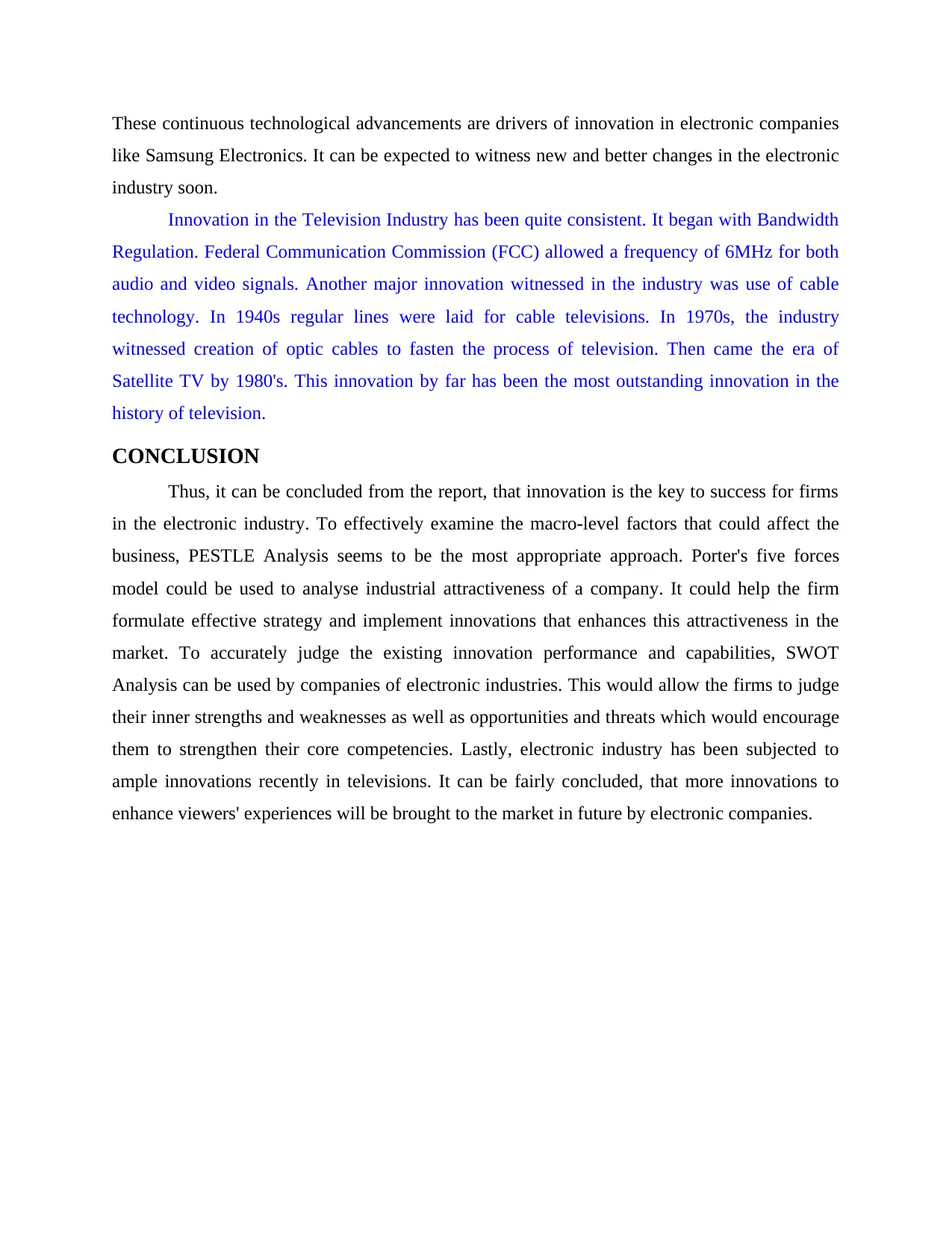
These continuous technological advancements are drivers of innovation in electronic companies
like Samsung Electronics. It can be expected to witness new and better changes in the electronic
industry soon.
Innovation in the Television Industry has been quite consistent. It began with Bandwidth
Regulation. Federal Communication Commission (FCC) allowed a frequency of 6MHz for both
audio and video signals. Another major innovation witnessed in the industry was use of cable
technology. In 1940s regular lines were laid for cable televisions. In 1970s, the industry
witnessed creation of optic cables to fasten the process of television. Then came the era of
Satellite TV by 1980's. This innovation by far has been the most outstanding innovation in the
history of television.
CONCLUSION
Thus, it can be concluded from the report, that innovation is the key to success for firms
in the electronic industry. To effectively examine the macro-level factors that could affect the
business, PESTLE Analysis seems to be the most appropriate approach. Porter's five forces
model could be used to analyse industrial attractiveness of a company. It could help the firm
formulate effective strategy and implement innovations that enhances this attractiveness in the
market. To accurately judge the existing innovation performance and capabilities, SWOT
Analysis can be used by companies of electronic industries. This would allow the firms to judge
their inner strengths and weaknesses as well as opportunities and threats which would encourage
them to strengthen their core competencies. Lastly, electronic industry has been subjected to
ample innovations recently in televisions. It can be fairly concluded, that more innovations to
enhance viewers' experiences will be brought to the market in future by electronic companies.
like Samsung Electronics. It can be expected to witness new and better changes in the electronic
industry soon.
Innovation in the Television Industry has been quite consistent. It began with Bandwidth
Regulation. Federal Communication Commission (FCC) allowed a frequency of 6MHz for both
audio and video signals. Another major innovation witnessed in the industry was use of cable
technology. In 1940s regular lines were laid for cable televisions. In 1970s, the industry
witnessed creation of optic cables to fasten the process of television. Then came the era of
Satellite TV by 1980's. This innovation by far has been the most outstanding innovation in the
history of television.
CONCLUSION
Thus, it can be concluded from the report, that innovation is the key to success for firms
in the electronic industry. To effectively examine the macro-level factors that could affect the
business, PESTLE Analysis seems to be the most appropriate approach. Porter's five forces
model could be used to analyse industrial attractiveness of a company. It could help the firm
formulate effective strategy and implement innovations that enhances this attractiveness in the
market. To accurately judge the existing innovation performance and capabilities, SWOT
Analysis can be used by companies of electronic industries. This would allow the firms to judge
their inner strengths and weaknesses as well as opportunities and threats which would encourage
them to strengthen their core competencies. Lastly, electronic industry has been subjected to
ample innovations recently in televisions. It can be fairly concluded, that more innovations to
enhance viewers' experiences will be brought to the market in future by electronic companies.
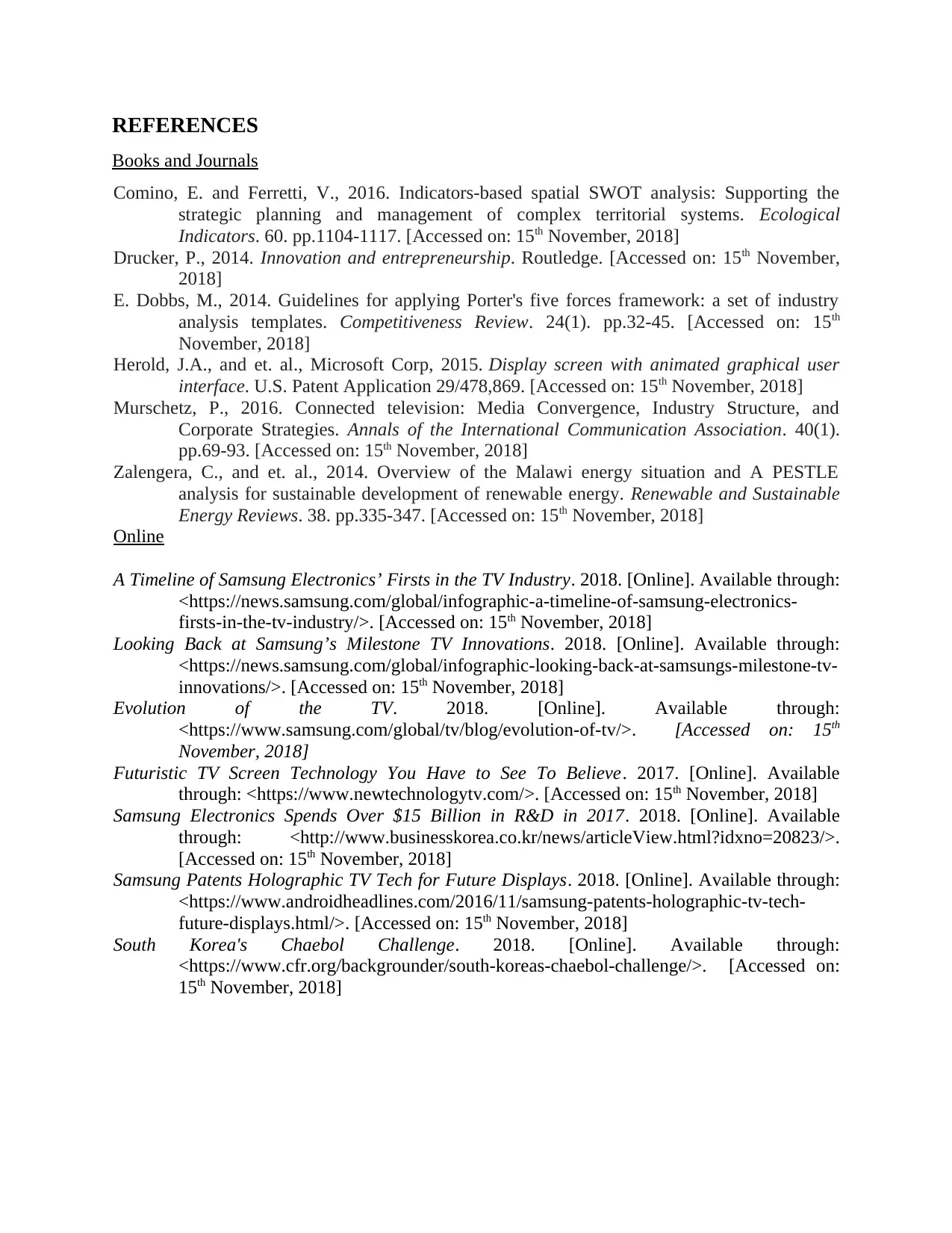
REFERENCES
Books and Journals
Comino, E. and Ferretti, V., 2016. Indicators-based spatial SWOT analysis: Supporting the
strategic planning and management of complex territorial systems. Ecological
Indicators. 60. pp.1104-1117. [Accessed on: 15th November, 2018]
Drucker, P., 2014. Innovation and entrepreneurship. Routledge. [Accessed on: 15th November,
2018]
E. Dobbs, M., 2014. Guidelines for applying Porter's five forces framework: a set of industry
analysis templates. Competitiveness Review. 24(1). pp.32-45. [Accessed on: 15th
November, 2018]
Herold, J.A., and et. al., Microsoft Corp, 2015. Display screen with animated graphical user
interface. U.S. Patent Application 29/478,869. [Accessed on: 15th November, 2018]
Murschetz, P., 2016. Connected television: Media Convergence, Industry Structure, and
Corporate Strategies. Annals of the International Communication Association. 40(1).
pp.69-93. [Accessed on: 15th November, 2018]
Zalengera, C., and et. al., 2014. Overview of the Malawi energy situation and A PESTLE
analysis for sustainable development of renewable energy. Renewable and Sustainable
Energy Reviews. 38. pp.335-347. [Accessed on: 15th November, 2018]
Online
A Timeline of Samsung Electronics’ Firsts in the TV Industry. 2018. [Online]. Available through:
<https://news.samsung.com/global/infographic-a-timeline-of-samsung-electronics-
firsts-in-the-tv-industry/>. [Accessed on: 15th November, 2018]
Looking Back at Samsung’s Milestone TV Innovations. 2018. [Online]. Available through:
<https://news.samsung.com/global/infographic-looking-back-at-samsungs-milestone-tv-
innovations/>. [Accessed on: 15th November, 2018]
Evolution of the TV. 2018. [Online]. Available through:
<https://www.samsung.com/global/tv/blog/evolution-of-tv/>. [Accessed on: 15th
November, 2018]
Futuristic TV Screen Technology You Have to See To Believe. 2017. [Online]. Available
through: <https://www.newtechnologytv.com/>. [Accessed on: 15th November, 2018]
Samsung Electronics Spends Over $15 Billion in R&D in 2017. 2018. [Online]. Available
through: <http://www.businesskorea.co.kr/news/articleView.html?idxno=20823/>.
[Accessed on: 15th November, 2018]
Samsung Patents Holographic TV Tech for Future Displays. 2018. [Online]. Available through:
<https://www.androidheadlines.com/2016/11/samsung-patents-holographic-tv-tech-
future-displays.html/>. [Accessed on: 15th November, 2018]
South Korea's Chaebol Challenge. 2018. [Online]. Available through:
<https://www.cfr.org/backgrounder/south-koreas-chaebol-challenge/>. [Accessed on:
15th November, 2018]
Books and Journals
Comino, E. and Ferretti, V., 2016. Indicators-based spatial SWOT analysis: Supporting the
strategic planning and management of complex territorial systems. Ecological
Indicators. 60. pp.1104-1117. [Accessed on: 15th November, 2018]
Drucker, P., 2014. Innovation and entrepreneurship. Routledge. [Accessed on: 15th November,
2018]
E. Dobbs, M., 2014. Guidelines for applying Porter's five forces framework: a set of industry
analysis templates. Competitiveness Review. 24(1). pp.32-45. [Accessed on: 15th
November, 2018]
Herold, J.A., and et. al., Microsoft Corp, 2015. Display screen with animated graphical user
interface. U.S. Patent Application 29/478,869. [Accessed on: 15th November, 2018]
Murschetz, P., 2016. Connected television: Media Convergence, Industry Structure, and
Corporate Strategies. Annals of the International Communication Association. 40(1).
pp.69-93. [Accessed on: 15th November, 2018]
Zalengera, C., and et. al., 2014. Overview of the Malawi energy situation and A PESTLE
analysis for sustainable development of renewable energy. Renewable and Sustainable
Energy Reviews. 38. pp.335-347. [Accessed on: 15th November, 2018]
Online
A Timeline of Samsung Electronics’ Firsts in the TV Industry. 2018. [Online]. Available through:
<https://news.samsung.com/global/infographic-a-timeline-of-samsung-electronics-
firsts-in-the-tv-industry/>. [Accessed on: 15th November, 2018]
Looking Back at Samsung’s Milestone TV Innovations. 2018. [Online]. Available through:
<https://news.samsung.com/global/infographic-looking-back-at-samsungs-milestone-tv-
innovations/>. [Accessed on: 15th November, 2018]
Evolution of the TV. 2018. [Online]. Available through:
<https://www.samsung.com/global/tv/blog/evolution-of-tv/>. [Accessed on: 15th
November, 2018]
Futuristic TV Screen Technology You Have to See To Believe. 2017. [Online]. Available
through: <https://www.newtechnologytv.com/>. [Accessed on: 15th November, 2018]
Samsung Electronics Spends Over $15 Billion in R&D in 2017. 2018. [Online]. Available
through: <http://www.businesskorea.co.kr/news/articleView.html?idxno=20823/>.
[Accessed on: 15th November, 2018]
Samsung Patents Holographic TV Tech for Future Displays. 2018. [Online]. Available through:
<https://www.androidheadlines.com/2016/11/samsung-patents-holographic-tv-tech-
future-displays.html/>. [Accessed on: 15th November, 2018]
South Korea's Chaebol Challenge. 2018. [Online]. Available through:
<https://www.cfr.org/backgrounder/south-koreas-chaebol-challenge/>. [Accessed on:
15th November, 2018]
1 out of 10
Related Documents
Your All-in-One AI-Powered Toolkit for Academic Success.
+13062052269
info@desklib.com
Available 24*7 on WhatsApp / Email
![[object Object]](/_next/static/media/star-bottom.7253800d.svg)
Unlock your academic potential
© 2024 | Zucol Services PVT LTD | All rights reserved.





